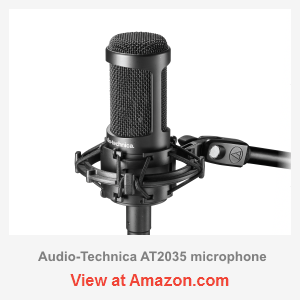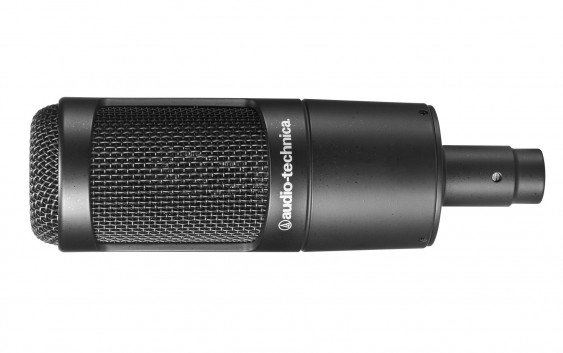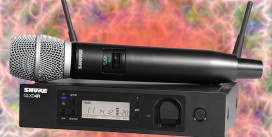AT2035 is an inexpensive back electret condenser from Audio Technica that boasts pretty clear and balanced sound with low noise floor. This mic is a veeery good tradeoff between price and quality and hence, an ideal choice for home studios where budget is a factor. AT2035 has cardioid polar pattern and large diaphragm that actually works for both vocals and instruments. Having said that, the essential features of pad and low pass make it an even better all-rounder that should handle most recording scenarios. With this baby, you can really put down some quality tracks at home…
Sound quality
Despite relying on back electret polarization, AT2035 sounds more like a typical true condenser. Back in the days, electret microphones used to be less reliable but as the technology stepped forward, the question of which is better is now arguable. Today it all depends on a particular capsule – some are just bad but some are good. Back electret capsules are still more likely to be found on budget mics though, whereas true condensers are being sold as premium. Yes of course, an externally polarized capsule can be seen as a more flexible solution but the question is do you really need this for a home studio?
Audio Technica AT2035 can be compared to AKG C214, which is actually studio grade true condenser. Both have very similar SPL (158 vs 156 dB with pad), Signal-to-noise ratio (82 vs 81 dB), Sensitivity (22.4 vs 20 mV/Pa) and Equivalent noise level (12 vs 13 dB-A). Believe it or not, every stat slightly favors AT2035, including the noise! Frequency response, of which we will talk later, is analogous too. Both mics produce a very natural sound, crispy and detailed on the high-end, rich and juicy on the bottom-end. However, AKG has a larger diaphragm and may sound a tad smoother, and, more flattery.
Frequency response
This mic features neutral, easy to work with frequency response, especially solid on the bottom end and mid-range. High end gets a very gentle boost that adds just a pinch of brightness. This starts after 2 kHz where it gains 1.5 dB of output and keeps steadily increasing all the way up until 13 kHz, peaking at 3.5 dB. For a budget mic with relatively large diaphragm, it’s quite nice to see such stable curve. And it’s not just a random pattern as some may presume. It is actually tailored that way as it adds some flavor of presence to your vocals as well as clarity for the instruments.
Noise levels
 AT2035 has an excellent self-noise of only 12 dB-A – such figures you will find on Neumann’s and other mics at least twice more expensive, whereas for most studio purposes 16 dB-A is considered more than enough and I’m talking about professional studios. In reality, even a very quiet environment will have ambient noise exceeding 12 dB threshold, so unless you are trying to record the ticking of a hand watch while being in a soundproof room, you will not be able to discern the self-noise produced by this mic. Keep in mind, preamps may add some noise too so get something decent to cross this off the list!
AT2035 has an excellent self-noise of only 12 dB-A – such figures you will find on Neumann’s and other mics at least twice more expensive, whereas for most studio purposes 16 dB-A is considered more than enough and I’m talking about professional studios. In reality, even a very quiet environment will have ambient noise exceeding 12 dB threshold, so unless you are trying to record the ticking of a hand watch while being in a soundproof room, you will not be able to discern the self-noise produced by this mic. Keep in mind, preamps may add some noise too so get something decent to cross this off the list!
Setup
If you’ve done recording before and have the equipment handy you’ll already know what to do. Audio Technica AT2035 connects through XLR interface and requires phantom power. It’s pretty much standard and being back electret it is also forgiving about voltage (Rated 11-52V DC). If you don’t own one already we do recommend getting an audio interface so you can connect it with pc. There are many options… Steinberg UR22MKII is a very powerful but inexpensive tool. Focusrite Scarlett is ok too – though kind of sucky compared to the above, but never settle for cheaper imitations to avoid headache.
Features, Build & Accessories
AT2035 has a standard Audio Technica’s body, which is identical to any 20XX, 30XX and 40XX models. It is solid, heavy and durable and does not need much handling care, unless you want to maintain its brand new look. It has two switches at the back for -10 dB pad and 80 Hz low cut. With pad, it can handle the maximum SPL of 158 dB at 1% THD. Just so that you understand, such sound pressure could rapture your eardrums in an instant. In reality, it is unlikely to achieve even if put next to a very loud guitar amp but anyway it’s nice to have that extra margin.
The low cut is also a good bonus: it can help reducing popping when up close as well as low frequency ambience when recording in less than ideal sound environment. In any event, do not forget to get some nice pop filter when recording vocals – this is a must for any LDC. This mic uses standard 5/8″ – 27 mounting thread and comes with adapter nut for 3/8″ – 16. The package also includes AT8458 shock mount, which alone costs around $50-60. Although made of plastic, it’s quite efficient in what it does and appears to be durable too. Considering the mic price, it’s a real steal!
Pros
|
Cons
|










An AKG C214 has an electret capsule also, not a true condenser as stated.
That’s interesting. I thought C214 was much like C414, which is a true condenser though with multiple patterns.
Very nice write up on the underrated 2035. IMO far too often overlooked.